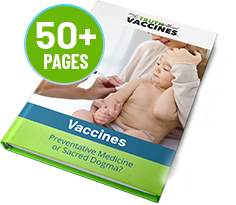The topic of vaccines and the current vaccination schedule is a complicated one to say the least. Even the basic concepts that public agencies such as the Centers for Disease Control and Prevention (CDC) use to determine a vaccine’s “effectiveness” are now under scrutiny and the subject of public debate. The main principle that public health organizations use to justify mass vaccination campaigns is called “herd immunity.”
So exactly what is “herd immunity” and how does it affect you and your family? Let’s take a look at what this concept is at the most basic level. Then we can dive deeper into how it has been used as a scientific basis for decades of mass vaccination mandates as well as why some claim that vaccine-related “herd immunity” is really a myth.
Herd Immunity: The Basics
If you are wanting a clear-cut definition of the term “herd immunity,” you are probably going to be disappointed. The definition appears to change depending on who uses it and how it is used. According to the Infectious Diseases Society of America:
“Some authors use it to describe the proportion immune among individuals in a population. Others use it with reference to a particular threshold proportion of immune individuals that should lead to a decline in incidence of infection. Still others use it to refer to a pattern of immunity that should protect a population from invasion of a new infection [italics added].”
Huh? Let’s go back to the origin of the term and see if that helps to clear things up.
The term “herd immunity,” (otherwise known as “the herd effect,” “community immunity,” “population immunity,” or “social immunity”) came about in the early 1920s and originally referred to the phenomenon of naturally-occurring immunity against a disease within a given population. Researchers at the time observed that once a large proportion of children had developed a natural immunity to the measles virus, the number of new cases decreased, even amongst children who were the most susceptible.
Another good, albeit drastic, example of naturally-occurring herd immunity was what occurred when measles infected Confederate barracks and hospitals during the American Civil War. The first stage of mass infection for any disease is called “high-dose exposure.” During the war, measles-afflicted soldiers were in very close quarters and their immune system defenses were low (caused by injury, exposure, low caloric intake, lack of hygiene, and low amounts of essential vitamins such as A and C). As a result, the virus spread easily and rapidly from soldier to soldier.
In this initial stage, the “herd immunity” amongst the soldiers was zero. The consequence was that many soldiers became ill and an estimated 1 in 20 who contracted it succumbed to the disease.
Following a typical pattern, herd immunity eventually occurred amongst the soldiers as rapidly as high dose exposure had initially occurred. According to gastroenterologist and vaccine expert Dr. Andrew Wakefield, in natural disease cycles within normal populations without vaccine interference, natural herd immunity occurs as a particular disease goes through 2-yearly epidemics; with each outburst of a disease, herd immunity rates dramatically increase.
In natural disease cycles, the initial epidemic may lead to massive morbidity. However, the upside is that natural immunity also leads to long-term immunity within a population overall. According to Dr. Wakefield, lifetime immunity limits opportunities for the replication and transmutation of a particular virus within individuals and within populations. He and others also cite increased hygiene levels as a major factor which can contribute to natural herd immunity.
As a consequence of natural Herd Immunity, in the developed world measles mortality had fallen by 99.6% before measles vaccines were introduced,” Wakefield said in a recent article for the movie Vaxxed.
To recap: the main thing to consider about the original definition of the term is that in the pre-vaccine era, “herd immunity” was thought to have occurred when overall population protection happened naturally. Naturally-occurring mass immunity is significant because this kind of immunity lasts a lifetime for the majority of people in a given population.
Herd Immunity in the Age of Vaccines
Even though vaccinations against viral agents such as smallpox became routine at the end of the 1800s, it really wasn’t until the mid-20th century that immunization advocates took the concept of naturally-occurring “herd immunity” and decided to run with it. They deduced that creating “herd immunity” through mass vaccination programs could have an even better effect at saving lives than naturally-occurring immunity could.
Thus, over the last several decades, “herd immunity” has been mostly equated with “mass disease eradication” through vaccination.
According to the National Institute of Allergy and Infectious Diseases (NIAID):
When a critical portion of a community is immunized against a contagious disease, most members of the community are protected against that disease because there is little opportunity for an outbreak.”
NIAID goes on to explain that vaccine-derived “community immunity” for a particular disease such as measles, mumps, or a flu strain can extend to those in the population who are not eligible to get the vaccine (pregnant women, newborns, and the immunocompromised, for example) as well as to those for whom the vaccine is not effective. This is because once a certain percentage of individuals get inoculated, the disease is considered “contained” within that population.
But exactly how many individuals within a population would have to be inoculated for “community immunity” to occur?
According to an interactive animated map provided by the College of Physicians of Philadelphia, as little as 40 percent of a population could potentially be vaccinated in order for “herd immunity” to start to show. For most contagious diseases, however, the conventional thinking is that a “herd immunity threshold” will not be established until the vaccinated population reaches between 80-95%.
WATCH OUR NEW DOCUMENTARY MINI-SERIES
THE TRUTH ABOUT VACCINES
60 Top Vaccine Experts Unite to Inform Parents and Ensure Your Child’s Health and Safety
Is Herd Immunity Relevant Today?
According to the Centers for Disease Control, routine vaccines given to children over the last two decades will wind up preventing “hundreds of millions” of illnesses and over 700,000 deaths in the U.S. alone. This sweeping statement is largely dependent on the CDC’s vaccine-dependent herd immunity or “social immunity” calculations.
Many experts say, however, that the whole concept of vaccine-induced “herd immunity” is a myth. They state that it is simply a false justification for decades of questionable mass vaccination programs and campaigns.
One of the main points these experts make is that, on an individual level, vaccine-derived immunity is a whole different animal than naturally-derived immunity. While naturally-developed immunity can last a lifetime, vaccine-induced immunity typically only lasts between two to ten years.
What’s more, this timeframe normally applies to “humoral immunity” only. Humoral immunity concerns immune system responses that take place within the extracellular spaces within the body. This is where most pathogens are able to spread, but it is not the only place they can do so.
This information may come as a surprise. After all, aren’t most vaccinations, such as MMR and tetanus, supposed to be for life?
Indeed, this was the prevalent line of thinking for the first several decades in which the mass vaccination agenda was in effect. Then it was discovered that, in fact, common immunization shots had a much shorter lifespan.
Why Are “Booster Shots” Considered Necessary?
Remember when “booster shots” came into the scene? They were a direct result of these findings. The known 2-10 year lifespan of most vaccinations is also one of the reasons why individuals of all ages are now encouraged (and in some states, required) to take multiple rounds of shots. More about the history of vaccine scheduling can be found HERE.
But how does the discovery of shorter vaccine lifespans call into question the conclusion that vaccines can result in “herd immunity?” Dr. Russell Blaylock, a U.S. neurosurgeon and author of several books and the well-known Blaylock Wellness Report, explains:
What this means is that at least half the population, that is the baby boomers, have had no vaccine-induced immunity against any of these diseases for which they had been vaccinated very early in life. In essence, at least 50% or more of the population was unprotected for decades.”
Public health organizations such as the CDC proclaim that the entire U.S. population would be at risk of a massive disease epidemic if the vaccine rate were to ever fall below 95%. Yet, according to Dr. Blaylock and others, the reality is that vaccine-induced “herd immunity” hasn’t existed in this country for decades. In fact, half of the U.S. population has lived the last 30 to 40 years of their lives without vaccine protection against many diseases. Yet no major epidemics have occurred.
When we examine the scientific literature, we find that for many of the vaccines, protective immunity was 30 to 40%, meaning that 70% to 60% of the public has been without vaccine protection,” says Blaylock, referring to the baby boomer generation. “Again, this would mean that with a 30% to 40% vaccine-effectiveness rate combined with the fact that most people lost their immune protection within 2 to 10 years of being vaccinated, most of us were without the magical 95% number needed for herd immunity.”
On the other hand, compliance with vaccination standards in an area does not necessarily prevent an outbreak. In 2011, one of the largest “post-elimination” measles outbreaks occurred in Quebec, Canada. In this area, the double-administered vaccine compliance was close to 97% – even higher than the recommended quota that would lead to “herd immunity,” according to conventional figures.
And in the United States, several measles outbreaks which occurred between 1971 and 2009 happened amongst inoculated children. This included an outbreak in Cincinnati in 1994, where 80% of the children affected had received a triple-dose of the MMR vaccine, and a 1986 outbreak in Corpus Christi, TX, where 99% of the youngsters afflicted had been vaccinated.
Outbreaks amongst the vaccinated population are not relegated to measles alone. A Canadian study published in The Journal of Pediatrics in 1989 found a 55% failure rate for the pertussis vaccine. Amongst the 526 individuals who had contracted the disease within the 28 months of the study, 91% had received at least three rounds of pertussis immunizations.
And according to the Ohio Department of Health (ODH), 50% of the reported whooping cough cases in that state in the late 1980s and early 1990s were amongst vaccinated individuals. In 2013, the ODH issued a press release urging all its citizens to get whooping cough booster shots after they discovered that pertussis (i.e. whooping cough) cases were up 20 percent that year. Yet, the rate for Tdap vaccinations in Ohio between 2011 and 2013 was roughly 82%, well within the standard “herd immunity” percentages.
Vaccine Education is Key
The decision to vaccinate yourself or your children should always be a personal one made with informed consent. Knowing the facts as much as possible on both sides of the vaccination debate is a vital part of that decision-making process, however. This includes knowing at least a little about the history and development of the key concepts that are currently used in determining vaccine policies that affect us all. Hopefully this information can help YOU make better choices about vaccines.
WATCH OUR NEW DOCUMENTARY MINI-SERIES
THE TRUTH ABOUT VACCINES
60 Top Vaccine Experts Unite to Inform Parents and Ensure Your Child’s Health and Safety
Sources and References:
“Herd Immunity”: A Rough Guide
The History of Vaccines – Timeline
Report shows 20-year US immunization program spares millions of children from diseases
Talking Science: Facts About Vaccines and Herd Immunity
Community Immunity (“Herd Immunity”) – US Department of Health and Human Services
Measles: Herd Immunity in the pre-vaccine era by Andrew Wakefield
Public Health Myth #4: Herd Immunity
The Deadly Impossibility Of Herd Immunity Through Vaccination, by Dr. Russell Blaylock
Whooping cough cases are up in Ohio leading health officials to urge up-to-date vaccinations









